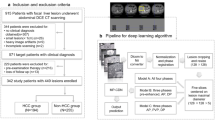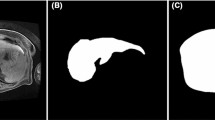Abstract
Purpose
Gadolinium ethoxybenzyl diethylenetriamine pentaacetic acid (Gd-EOB-DTPA)-enhanced magnetic resonance imaging (MRI) has high diagnostic accuracy in the detection of liver lesions. There is a demand for computer-aided detection/diagnosis software for Gd-EOB-DTPA-enhanced MRI. We propose a deep learning-based method using one three-dimensional fully convolutional residual network (3D FC-ResNet) for liver segmentation and another 3D FC-ResNet for simultaneous detection and classification of a focal liver lesion in Gd-EOB-DTPA-enhanced MRI.
Methods
We prepared a five-phase (unenhanced, arterial, portal venous, equilibrium, and hepatobiliary phases) series as the input image sets and labeled focal liver lesion (hepatocellular carcinoma, metastasis, hemangiomas, cysts, and scars) images as the output image sets. We used 100 cases to train our model, 42 cases to determine the hyperparameters of our model, and 42 cases to evaluate our model. We evaluated our model by free-response receiver operating characteristic curve analysis and using a confusion matrix.
Results
Our model simultaneously detected and classified focal liver lesions. In the test cases, the detection accuracy for whole focal liver lesions had a true-positive ratio of 0.6 at an average of 25 false positives per case. The classification accuracy was 0.790.
Conclusion
We proposed the simultaneous detection and classification of a focal liver lesion in Gd-EOB-DTPA-enhanced MRI using multichannel 3D FC-ResNet. Our results indicated simultaneous detection and classification are possible using a single network. It is necessary to further improve detection sensitivity to help radiologists.








Similar content being viewed by others
References
Akai H, Kiryu S, Matsuda I, Satou J, Takao H, Tajima T, Watanabe Y, Imamura H, Kokubo N, Akahane M, Ohtomo K (2011) Detection of hepatocellular carcinoma by Gd-EOB-DTPA-enhanced liver MRI: comparison with triple phase 64 detector row helical CT. Eur J Radiol 80(2):310–315. https://doi.org/10.1016/j.ejrad.2010.07.026
Berger-Kulemann V, Schima W, Baroud S, Koelblinger C, Kaczirek K, Gruenberger T, Schindl M, Maresch J, Weber M, Ba-Ssalamah A (2012) Gadoxetic acid-enhanced 3.0 T MR imaging versus multidetector-row CT in the detection of colorectal metastases in fatty liver using intraoperative ultrasound and histopathology as a standard of reference. Eur J Surg Oncol 38(8):670–676. https://doi.org/10.1016/j.ejso.2012.05.004
Jansen MJA, Kuijf HJ, Niekel M, Veldhuis WB, Wessels FJ, Viergever MA, Pluim JPW (2019) Liver segmentation and metastases detection in MR images using convolutional neural networks. J Med Imag 6(4):044003. https://doi.org/10.1117/1.jmi.6.4.044003
Bousabarah K, Letzen B, Tefera J, Savic L, Schobert I, Schlachter T, Staib L, Kocher M, Lin M (2020) Automated detection and delineation of hepatocellular carcinoma on multiphasic contrast-enhanced MRI using deep learning. Abdom Radiol. https://doi.org/10.1007/s00261-020-02604-5
Takenaga T, Hanaoka S, Nomura Y, Nemoto M, Murata M, Nakao T, Miki S, Yoshikawa T, Hayashi N, Abe O (2019) Four-dimensional fully convolutional residual network-based liver segmentation in Gd-EOB-DTPA-enhanced MRI. Int J Comput Assist Radiol Surg 14(8):1259–1266. https://doi.org/10.1007/s11548-019-01935-z
Jansen MJA, Kuijf HJ, Veldhuis WB, Wessels FJ, Leeuwen MS, Pluim JPW (2017) Evaluation of motion correction for clinical dynamic contrast enhanced MRI of the liver. Phys Med Biol 62(19):7556–7568. https://doi.org/10.1088/1361-6560/aa8848
Nomura Y, Sato I, Hanawa T, Hanaoka S, Nakao T, Takenaga T, Hoshino T, Sekiya Y, Miki S, Yoshikawa T, Hayashi N, Abe O (2020) Development of training environment for deep learning with medical images on supercomputer system based on asynchronous parallel Bayesian optimization. J Supercomput 76(9):7315–7332. https://doi.org/10.1007/s11227-020-03164-7
PyTorch. https://pytorch.org/ Accessed 18 Jan 2021
Dai J, Qi H, Xiong Y, Li Y, Zhang G, Hu H and Wei Y (2018). Deformable convolutional networks, 6003. https://github.com/msracver/Deformable-ConvNets Accessed 18 Jan 2021
Zhou J, Wang W, Lei B, Ge W, Huang Y, Zhang L, Yan Y, Zhou D, Ding T, Wu J, Wang W (2021) Automatic detection and classification of focal liver lesions based on deep convolutional neural networks: a preliminary study. Front Oncol 10:1–11. https://doi.org/10.3389/fonc.2020.581210
Bree RL, Schwab RE, Glazer GM, Fink-Bennett D (1987) The varied appearances of hepatic cavernous hemangiomas with sonography, computed tomography, magnetic resonance imaging and scintigraphy. Radiographics 7(6):1153–1175. https://doi.org/10.1148/radiographics.7.6.3321218
Acknowledgements
The Department of Computational Radiology and Preventive Medicine, the University of Tokyo Hospital, is sponsored by HIMEDIC Inc. and Siemens Healthcare K.K. This work was supported by Japan Society for the Promotion of Science (JSPS) KAKENHI Grant Numbers 17K17653 and 20K20215. This work was also supported by the Joint Usage/Research Center for Interdisciplinary Large-Scale Information Infrastructures and High-Performance Computing Infrastructure Projects in Japan (Project IDs: jh170036-DAH, jh180073-DAH, jh190047-DAH, and jh200042-DAG).
Author information
Authors and Affiliations
Corresponding author
Ethics declarations
Conflict of interest
The authors declare that they have no conflict of interest.
Ethical approval
All procedures performed in studies involving human participants were in accordance with the ethical standards of the institutional and/or national research committee and with the 1975 Helsinki Declaration, as revised in 2008(5). For this type of study, formal consent is not required.
Additional information
Publisher's Note
Springer Nature remains neutral with regard to jurisdictional claims in published maps and institutional affiliations.
Rights and permissions
About this article
Cite this article
Takenaga, T., Hanaoka, S., Nomura, Y. et al. Multichannel three-dimensional fully convolutional residual network-based focal liver lesion detection and classification in Gd-EOB-DTPA-enhanced MRI. Int J CARS 16, 1527–1536 (2021). https://doi.org/10.1007/s11548-021-02416-y
Received:
Accepted:
Published:
Issue Date:
DOI: https://doi.org/10.1007/s11548-021-02416-y




